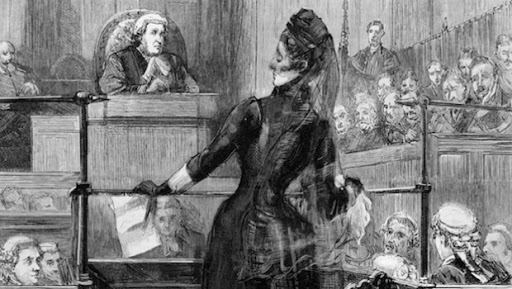The Master Etcher and the Queen of Heeley: A Sheffield Murder
- Holly Roberts

- Jan 15, 2021
- 6 min read

Thanks to the likes of Dickens and Conan Doyle we are all familiar with the rogues and swindlers of the late 19th century. It’s surely a fact that in dark, smoggy cities murderers, forgers and pick-pockets were waiting around every corner and of course, you’d recognise them: raggedy rogues and pauper pickpockets, but was that really the case?
It’s 1880 and Sheffield is a thriving industrial city; a bustling and modern northern metropolis. It is the ideal setting for a Dickensian tale of woe and wickedness and the lead character in this story was one even Charles himself would have been proud of…
Kate Dover was supposedly a bit of a Sheffield ‘sweetheart’, so fittingly, she ran a local sweetshop on London Road in the Sheffield suburb of Heeley. In 1880 Kate was a working-class 27 year old and the daughter of a woodcarver. She loved fine things and impressively retained an independent lifestyle in a period in which women were expected to be quiet, compliant and dependent on their husbands. Kate appeared to be none of these things and her extravagant appearance and fashionable attire eventually earned her the title of the ‘Queen of Heeley’.

Image of typical fashion of the period
Kate was also a student of the Sheffield School of Art, and many of her flower pictures showed "considerable merit". In the late 1890s she was "a prominent member of the Good Templars", at the Excelsior Lodge, Sheffield and proudly claimed to be a vegetarian teetotaller. As well as an artistic talent, she was known to have had an ‘excitable character’ and to have been highly educated, writing a book at the age of nine.
It may have been their shared love of art, their intelligence or merely his sizable pockets that brought Kate Dover and Thomas Skinner together but whatever it was it would prove to be fatal for one of them.
Thomas Skinner was an etcher, inventor and oil-painter from Sheffield. Starting out as a cutler alongside his father at Joseph Rodgers & Sons, Thomas went on to lead an impressive life going on to invent a method of etching that enabled mass production. Thomas travelled and gained patents for his inventions in both the UK and America and even saw his work mentioned in the 1851 Great Exhibition. His success meant that once returned to Sheffield, he was able to enjoy a comfortable life living off the funds from the patents and various other works.

Cutlery engraved using the method invented and patented by Thomas Skinner
In 1880, 61 year old Thomas was living at 24 Glover Place, Sheffield. Having lost his wife in 1876, friends and acquaintances commented on his ‘over-familiarity’ with his servants and his attachment to drink. Whilst his family, particularly his sister, denied that Thomas was a drunkard many reported him to often be drunk in the later years of his life.
Regardless of Thomas’ perhaps less appealing characteristics in his later life, he remained a talented painter and according to his sister was ‘A man of superior intellectual ability…He was a kind, genial, sympathetic man, with a very strong love nature’. He was also a man of high-esteem, well-known both in Sheffield and throughout his trade.
Despite an age difference, Thomas and Kate found their way to each other. According to letters written by Kate, they met when Thomas bought sweets from the shop on London Road and eventually they began courting. Soon Kate took on the role of housekeeper for Thomas, replacing a miss Jane Jones. According to letters written by Kate and love letters between the two, their relationship blossomed and from sweethearts they became engaged to be married. Some disapproved of the relationship, including the former housekeeper Jane Jones who apparently often tried to cause problems and was ‘never kind’ to Kate but nevertheless, Thomas and Kate pursued their feelings. Later, their love letters were published in the press and they suggested a loving and affectionate relationship, indicative of a couple due to be married the following year.
But on a dark December evening in 1881 a Dr Harrison was called to Glover Street. Both Kate and Thomas were feeling unwell, Thomas was found to be vomiting and writhing in pain and Kate was stated to have been feeling a ‘burning sensation’.
At 9pm Thomas Skinner was pronounced dead. The post mortem determined the cause to be arsenic poisoning and Kate was taken to Highfield Police Station to await further news from the inquest.
Arsenic
Arsenic pervaded almost every aspect of life in nineteenth century Britain, leaving a considerable toll of death and illness. A by-product of an emerging smelting industry, arsenic was cheap and readily available as a rat killer by the early 1800s. Arsenic also was odourless and tasteless and easily confused with flour or sugar and other cooking essentials. By the 1830s, morbid descriptions of murders with arsenic terrified the public and became a staple of the British popular press.
During this time the main test for arsenic was the Marsh Test, invented by James Marsh. However, methods for detecting it had been around since 1770!
After thorough testing it appeared that traces of arsenic were present in the meal that Kate had prepared for her lover, in particular the stuffing! The stuffing was prepared and served separately and according to the court records Thomas’ servant observed that Kate had a very small portion of the poisoned stuffing, declaring that she felt ill. Sheffield’s public analyst Alfred H. Allen observed that Thomas’ stomach contained eight grains of arsenic, only two grains are required for any fatal dose.
The police investigation eventually concluded that Kate had indeed poisoned her beloved Thomas, purchasing arsenic from a chemist on Abbeydale Road, Sheffield claiming she required it to colour artificial flowers. Kate had also been seen to be telling servants and individuals in the public house that Thomas was ill and that he would probably die the day before the poisoning.
With the evidence mounting, Kate was charged with Thomas’ murder and the press went wild. Kate became famous and the crime hit newspapers nationally and internationally. The case had drawn so much attention that the court (Leeds Assizes) were jam-packed:
The case had created the greatest possible public interest, and the court was densely crowded, admission being obtained by ticket. Indeed, never since the trial of Charles Peace has the public excitement been so intense, hundreds of people being unable to obtain admission. Ladies mustered in unusually strong force. The prisoner, upon being placed in the dock, walked very slowly, and appeared to feel acutely her terrible position. She sobbed violently, and pleaded not guilty in a feeble voice.
The Sheffield poisoning case, trial of Kate Dover". The Liverpool Daily Post. Liverpool. 7 February 1882. p. 6 col4. Retrieved 13 July 2019 – via British Newspaper Archive.
Yet after an intense trial Kate was found guilty of manslaughter. She had narrowly escaped the conviction of wilful murder as it was believed Kate had only ever intended to make Thomas unwell so that she could accuse the former housekeeper, Jane Jones, with the poisoning and be rid of her at last. Whether or not true, it is very likely that Kate’s well known personal characteristics helped with her lesser conviction and her appearance in court only furthered any idea of her as the remorseful, grieving widow who made a tragic mistake. Later, a juror stated that they thought the reason they reached the verdict of manslaughter was because the majority did not want to hang a woman.
Photographs of woman in dock and Leeds Assizes: a holding cell, the stairs from the cells and the judge's chair from the dock.
On 8th February 1882 a sobbing and quivering Kate was convicted and sentenced to penal servitude for life. Kate ‘fell into a heap’ and was immediately carried away to the cells. Kate began her sentence at Wakefield Prison where she sent home many letters and drawings of flowers but quickly went on to Woking Female Prison where she spent most of her sentence.
Life for Kate in Woking would have been a stark contrast to her previous lifestyle. Although the women were permitted to partake in activities like needlework the living standards were purposefully grim and several disciplinary stages were employed for every convict in order to debase and remove all femininity, independence and identity. It was a harsh and cruel environment. In 1895 a petition to the Home Secretary, which was permitted after 15 years' servitude, was raised by the 1882 trial's counsels for her defence and the prosecution, for Kate’s release from prison. However the Home Secretary declined the request. By 1901 Kate was out of prison, so she had most likely served between thirteen and nineteen years.

Woman in punishment cell at Woking Female Prison
On her release Kate returned to South Yorkshire and lived with her sister in Rotherham. Kate never married and in 1925 she died of bronchitis and heart failure aged 69. At her death she was residing at 25 St Ann's Road, Rotherham. She had been living there with her widowed brother-in-law Edward Sissons, who was in attendance at her death.
Regardless of her intention the Queen of Heeley had fallen far from her fabulous frocks and glamorous cosmetics. This intelligent woman had ultimately traded her artistic lifestyle for the hard life of penal servitude. What do you think of Kate? Heartless murderess or naive, desperate fiance?
You can learn more about Kate and her crime at the upcoming police exhibition at the museum. See website for more info.
Sources:
The British Newspaper Archive
.png)

















Comments